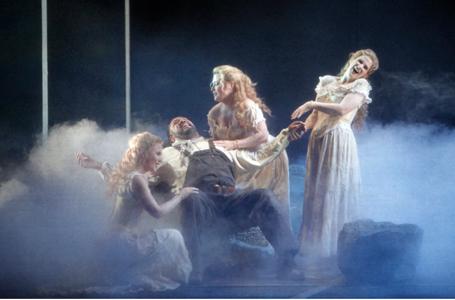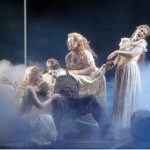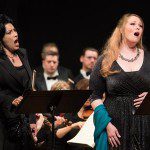Performing Arts Spring Preview
By • March 10, 2016 0 971

People love opera — madly, passionately, unreasonably, joyfully.
People hate opera — disdainfully, passionately, unreasonably, deeply.
Count me among the swains.
I don’t say this lightly. My connections to opera have been tangential, furtive, through film and snippets of famous music (both Mozart and Muzak) and by the fact that my son’s mother was a trained mezzo-soprano.
These things come slowly, at least to me. I do not have much of a baptismal or sudden conversionary nature. Things accumulate.
I remember seeing a film version of “La traviata” in which an impassioned Placido Domingo exchanges words and greetings in song with the sad, doomed courtesan Violetta. The music and the singing were soaring, aiming for heaven by way of heartbreak (or so it felt ), until I saw the titles, which merely noted, “Good morning, darling” or “Fine day, isn’t it?” After all that engulfing vocalizing, this was a deflating discovery.
Only later did I realize that in opera every word counts because it is sung. Every word is an attempt to express a precise feeling. The words may not be literature. Librettos are the Achilles’ heel of opera. You read them at peril of boredom. Yet, the music somehow invests the words with powerful, ultimate emotion. Libretto and music are usually unequal partners. When they are equal, well, bravissimo to you, Wolfang Amadeus Mozart and Lorenzo Da Ponte. And you, too, Herr Richard Wagner.
Which brings us to the Ring … or the Ring Cycle … or “The Ring of the Nibelung” … or, as they say, casually, among the Germanic tribes: “Der Ring des Nibelungen.”
Basically, it’s THE RING: Wagner’s cycle of four operas (he thought of them as a new genre) — “The Rhinegold,” “The Valkyrie,” “Siegfried” and “Twilight of the Gods” — inspired by the Norse sagas and the late 12th-century German epic poem about a medieval royal family, “The Song of the Nibelungs.” After 25 years of writing and composing, give or take, the cycle premiered at the first Bayreuth Festival in August of 1876.
And now it’s here, at Washington National Opera, from April 30 to May 22: Three cycles, 12 performances altogether, each running around four hours.
Those 16 hours (times three) are packed with gods. There are gods and demi-gods and semi-gods, to the point where you could exclaim, “Who Let the Gods Out?” They have names like Fafner, Fasolt, Woglinde, Wellgunde, Flosshilde, Fricka and the God of Gods, Wotan. There’s Alberich, the evil dwarf and maker of the ring. There’s Erda the earth goddess and the indomitable Brunnhilde and Siegmund and Sieglinde (who unfortunately fall in love) and Schwertleite and Mime and the Wanderer and the Forest Bird and the Norns. And there’s Siegfried, hero of heroes.
Mostly, there is Wagner, the most difficult of men and human beings, the most difficult of composers and the most difficult of geniuses. He trails behind him a century and more of reputation, some of it marred by misguided admirers who made aspects of his sometimes bizarre philosophy into Teutonic ideals.
He wrote other operas, of course: “The Flying Dutchman,” “Tannhauser,” “Loehengrin” and the spectacular “Tristan and Isolde,” staged here in 2013. But the cycle achieves something that Wagner talked about a lot (and largely achieved): total theater, the art of fusing music, drama, literature and the visual arts into one.
WNO Artistic Director Francesca Zambello brings her gift for meeting challenges and flair for the fresh to this project. She’s done it before, at San Francisco Opera, and has conductor Philippe Auguin beside her, along with Michael Yeargan’s sets, Catherine Zuber’s costumes and Denni Sayers’s choreography.
The cast includes such stars as Elizabeth Bishop as Fricka, Alan Held as Wotan, Soloman Howard as Fafner, David Cangelosi as Mime, Lindsay Ammann as Erda, Christopher Ventris as Siegmund, Nina Stemme and Catherine Foster as Brünnhilde and Daniel Brenna as Siegfried.
In the WNO brochure, the descriptions are very Wagnerian, like a cinematic trailer:
• “A mythical ring stolen. A powerful curse unleashed.” (“The Rhinegold”)
• “A forbidden love ignited. A defiant warrior avenged.” (“The Valkyrie”)
• “A fearless hero empowered. A dangerous quest begun.” (“Siegfried”)
• “A doomed love transcended. A fractured world restored.” (“Twilight of the Gods”).
Wagner was a gifted librettist; his books for his operas read like free-flowing utterances, like a very Germanic Whitman, all exclamation, pure heart, pain, glory and the deepest sort of love. His music and his words speak to all the feelings and stories we never think of ourselves as living, but imagine nevertheless. He aspires to the total, and if he’s not Wotan, he probably comes close.
As Zambello urges us: “On to Valhalla!”
Washington is a pretty fine opera area. It lets you reach out to opera in all of its manifestations, some of them as familiar as your password, some of them hardly ever seen live (and therefore also precious). There are companies big, small and medium-size, from Washington National Opera and Wolf Trap to the Washington Savoyards — our Gilbert and Sullivan specialists — and Opera Camerata.
Washington Concert Opera, founded in 1986, is dedicated, especially under Artistic Director and Conductor Antony Walker, to presenting star-level international singers with a professional orchestra and chorus in concert versions of rarely performed works by renowned composers.
This spring’s offering is from Gaetano Donizetti, one of the leading composers of bel canto (Italian for beautiful singing) operas, including “Lucia di Lammermoor,” famous for its mad scene. Washington Concert Opera will be presenting the French version of Donizetti’s “La favorite” on March 4 at Lisner Auditorium. Written at the height of his career, it is one of the few operas, we’re told, that features a mezzo-soprano in the title role.
The title role in question is that of Léonor, the King of Castille’s mistress, who falls in love with a monk, who falls in love with her. All this — including forbidden love, of which there is a copious amount in 19th-century operas — is set during the Moorish invasion of Spain, so that you have painful but passionate love, war, big arias, impassioned orchestral writing and a spectacular chorus. Kate Lindsey appears as Léonor, Randall Bills as the monk Fernand, John Relyea as Father Balthazar, Rolando Sanz as Don Gaspar, Joélle Harvey as Inès and Javier Arrey as the King of Castile.
Opera Lafayette, founded in 1995 by Conductor and Artistic Director Ryan Brown, has a specialty also. It is a period-instrument ensemble focused on the French 18th-century opera repertoire and its precursors, influences and artistic legacy. Performing in major theaters in Washington, New York and abroad (including France) and recording on the Naxos label, the company is known for presenting rediscovered masterpieces and creating a recorded legacy.
This year’s productions have included the baroque opera “Catone in Utica” (which was also performed in the summer at the Glimmerglass Festival in Cooperstown, New York) and the 19th-century opera “Une Éducation Manquée.” Coming up April 9 at Lisner will be “Opera and the French Revolution,” including scenes from “Sapho,” “Médée” and Œdipe à Colone.”
- Alberich, portrayed by baritone Gordon Hawkins, tries to seduce the three Rhinemaidens in “The Rhinegold,” the first opera in WNO’s Ring cycle. Photo by Cory Weaver. | Courtesy Washington National Opera.



